Excerpts from Jim Conrad's
Naturalist Newsletter
from the March 21, 2010 Newsletter issued from Hacienda Chichen Resort beside Chichén Itzá Ruins, central Yucatán, MÉXICO
SPANISH PLUM/ RED MOMBIN FLOWERING
Another small tree flowering nowadays, also completely leafless because of the dry season, is the Spanish Plum, also called Red Mombin, SPONDIAS PURPUREA, a member of the Poison Ivy or Cashew Family, the Anacardiaceae. It's native from southern Mexico to northern Peru and Brazil and also widely planted in many tropical countries throughout the world. You can barely see the small flowers tightly clustered along treetop branches below:
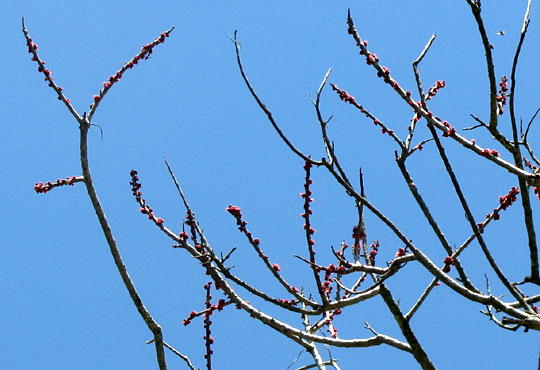
The flowers' petals are only 3 mm long (1/10th inch), so these are tiny flowers. Other pictures I find of them on the Internet show the flowers in looser clusters. I suspect the reason these flowers' clusters are so tight and small is that it's early in the flowering period, plus the dry season is a limiting factor. A close-up of the flowers is below:
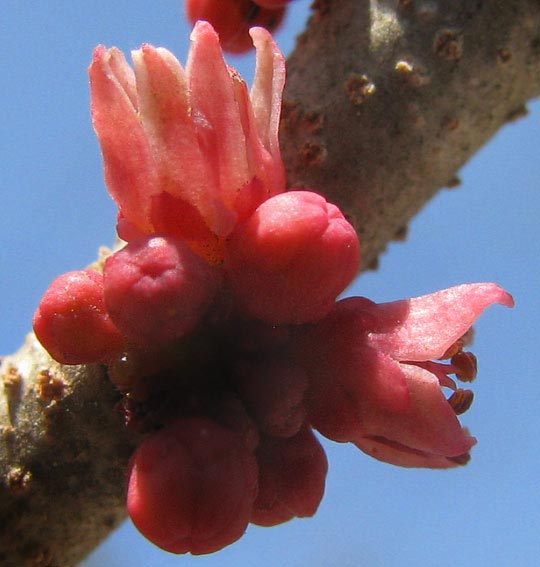
Spanish Plum flowers are supposed to have a 5-lobed calyx, 5 petals and 10 stamens, but the top flower in the above picture appears to have eight or so petals. I don't know what's happening there, but it's true that often organisms that have been domesticated or under cultivation for a long time develop irregular features.
Spanish Plum or Red Mombin, also called Hog Plum, Jocote, Purple Mombin and a host of other names, is called Ciruela by the locals here, which is the general Spanish name for the plum. Mombin fruits look and taste somewhat like northern plums, except that they have a larger seed different from a plum seed. Mombins and northern plums belong to entirely different families, so the similarities are based on other factors than relationship.
issued on February 20, 2020 from Tepakán, Yucatán, MÉXICO
FLOWERS UP CLOSER
The ranch's Spanish Plum trees, sometimes called Red Mombins, were the first to greet the dry season by dropping all their leaves, and now thumbnail-size clusters of tiny, red flowers are emerging from the leafless stems, a cluster shown below.
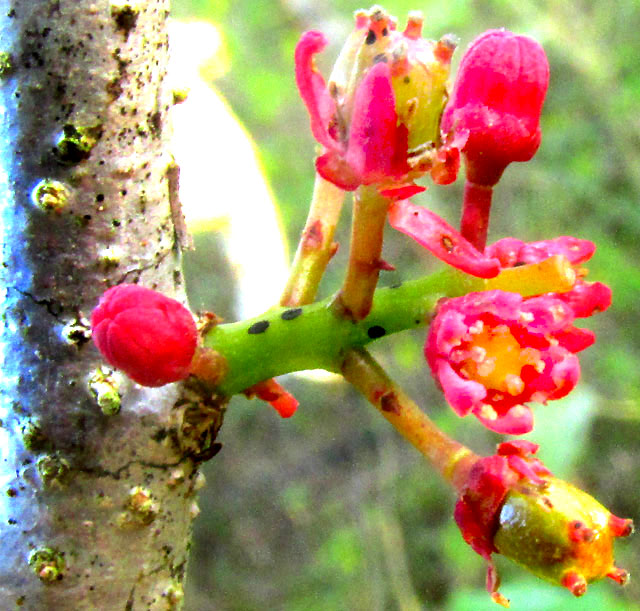
These trees are "polygamous," which in botany means that unisexual male or female flowers as well as flowers bearing both sexual parts occur on the same tree. In the above picture you see that some flowers bear swelling ovaries -- the future fruits -- while others don't. Interestingly, the ovaries bear 4-5 stigma-tipped styles at their tops, which is OK for members of the Cashew/Poison Oak Family, to which the tree belongs.
from the May 12, 2007 Newsletter issued from Sierra Gorda Biosphere Reserve, QUERÉTARO, MÉXICO
SPANISH PLUMS IMPOSSIBLE TO IGNORE
If you ride down a road anyplace in this area two trees are more eye-catching than all others, both planted around people's homes: First, there's the awesomely crimson-blossomed Poinciana I told you about last week, and; second, there's a fruit tree with perfectly leafless branches very heavily loaded with oval, green, inch-long fruits. You can see a typical one of these below:
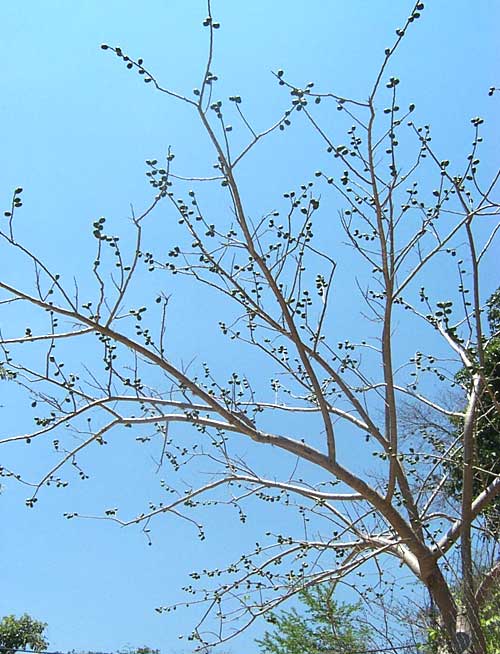
That's a close-up of three green fruits, which will turn yellow upon maturity, below:
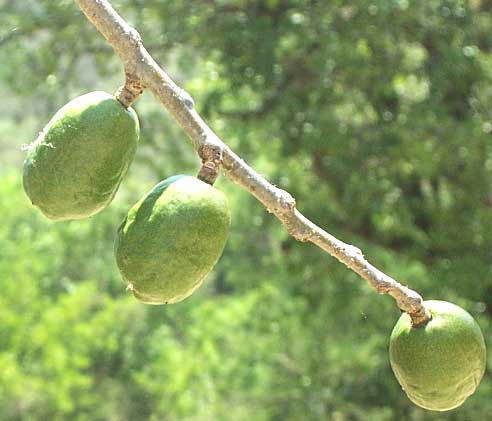
Mexicans call the tree "Ciruelo," which translates to "plum," but the fruit is unlike what North Americans think of as a plum. In other parts of Latin America it goes by the name of Jocote. In English we call it Spanish Plum, Mombin, and other names. There's a species with both yellow- and red-fruited forms, Spondias purpurea, and there's another closely related species, Spondias mombin, which produces only yellow fruits. In Spondias purpurea flowers and fruits occur along the stem, while in Spondias mombin they're clustered at the end of the branch. Therefore, what we have above is the yellow-fruited form of Spondias purpurea. These are members of the Cashew Family, in which we also find mangos, sumacs and Poison Ivy.
One reason the species is so popular is that its fruit can be eaten raw, used in preserves, made into jellies and, maybe most popular, used as the base for a sweet drink. I find its taste OK, but not to be compared with something like a fig or an apple. The trees ubiquity here may rest mainly on the fact that it doesn't need much care and thrives on marginal soils. One weakness is that it doesn't tolerate frosts.
Spanish Plum has been grown for so long that several horticultural varieties have emerged. The red-fruited form seems to receive top billing on the Internet, but the yellow-fruited one is much more common here. Also there are purple ones. Don Gonzalo says they taste pretty much the same.
You might enjoy reading the report of Allison Miller, a graduate student at Washington University in St. Louis, who traveled through Central America studying domesticated Spanish Plum populations. Allison found populations adapted for service in orchards, around people's homes, as living fences, cultivated in forests, as well as a few wild populations. Her interesting story, with pictures, is at http://www.mobot.org/MOBOT/Research/jocote/jocote.shtml.
from the June 22, 2007 Newsletter issued from Sierra Gorda Biosphere Reserve, QUERÉTARO, MÉXICO
SPANISH PLUMS ARE RIPE
Jalpan's Spanish Plums are finally maturing and I'm eating my share. Last weekend as I hiked through a village in the valley below San Juan, Zoyapilca, I met two old women and a young man coming down the road, each carrying two buckets filled to their brims with Spanish Plums. On my walk to the market there's one place where the sidewalk is dangerously slick with squashed, fallen plums. Three plums are shown in my hand below:
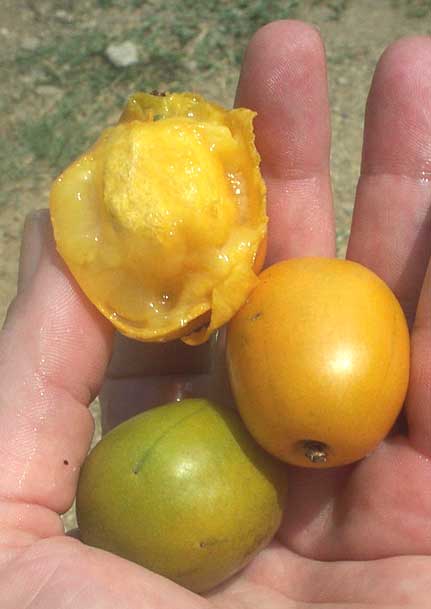
Though Spanish Plums belong to an entirely different plant family from northern plums, you can see why they're called plums. They look and taste like northern plums, and similarly can be eaten raw and made into preserves. However, note the large, hard, white, blocky seed, which is very unlike the northern plum's lens- shaped pit. Spanish Plums belong to the mostly tropical Cashew Family, in which we find not only cashew and mango trees but also sumac, Poison Oak and Poison Ivy.
Here people call the fruit Ciruela, which means plum, and they always tell you that there are two kinds, a yellow one and a red one. So, this is the yellow-fruited form of SPONDIAS PURPUREA.
Nowadays the trees' pinnately compound, walnut-tree-like leaves have emerged and the plentiful yellow fruits set amid fresh, emerald green leaves are very pretty.
from the April 24, 2011 Newsletter issued from Hacienda Chichen Resort beside Chichén Itzá Ruins, central Yucatán, MÉXICO
RED SPANISH PLUMS RIPENING
In Pisté around quite a few homes nowadays one sees leafless or near-leafless, small trees bearing loads of spherical, green to red, plum-like fruits, as shown below:
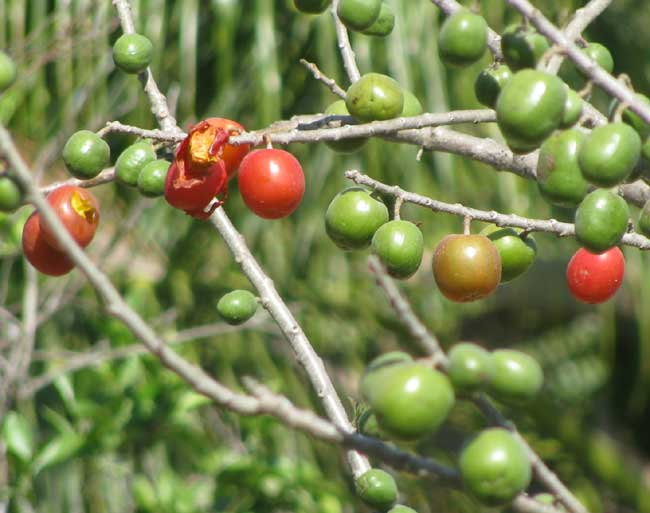
Some trees are issuing terminal sprouts bearing pinnately compound leaves like those of sumac, as seen below:
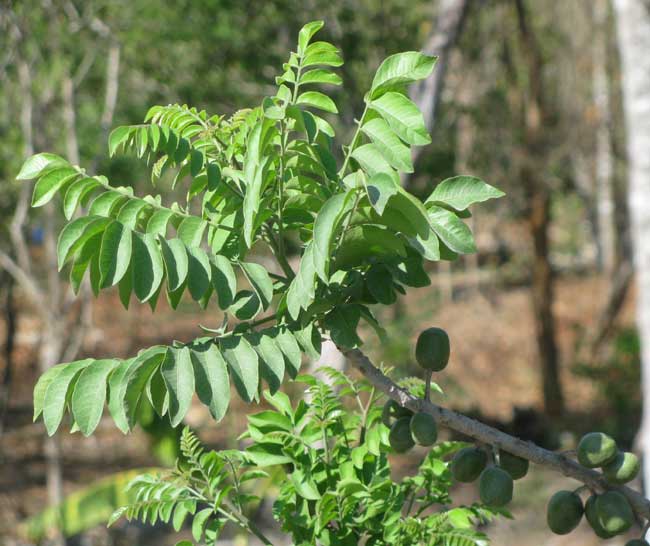
The leaf similarity to sumac isn't incidental, because here we're dealing with the Red Spanish-Plum, or Hog Plum, SPONDIAS PURPUREA, a member of the Cashew Family, to which sumac also belongs. Also in that family we find mango, pistachio, and Poison Oak and Poison Ivy.
We've met Spanish Plums before, but the fruits we had then were yellow. In fact Spanish Plum fruits are very variable, ranging from purple, dark- or bright-red, orange, or yellow, to red-and-yellow. They vary from 1 to 2 inches in length (2.5-5 cm) and come in a variety of roundish shapes.
In Spanish most people call the tree Ciruelo, which is the regular word for "plum tree." (Ciruela, ending in "a" instead of "o," means "plum fruit.") Since our Northern plums are members of the Rose Family, the Yucatán's Red Spanish Plums clearly have very little to do with them -- except that the fruits at first glance are very similar. In the English-speaking world the name Mombin also is used -- Red Mombin for this one, Yellow Mombin for a similar species with yellow fruits.
Inside the Red Spanish Plum there's a stone much larger than that of a Northern plum, and consequently there's much less to eat. Here Red Spanish Plums are eaten raw, cooked into jelly, or mashed between the fingers and strained for a juice that makes a nice- tasting drink.
No matter how good they taste, however, there's always the problem of those big stones, and nowadays it seems a lot of people just don't have time for such arduous eating, especially young people. Also, the fruits are given to being infested with worms.
Medicinally the fruits have been considered as diuretic, and fruit extracts derived from boiling in water are used to bathe wounds and mouth sores. The bark, which contains much tannin, is astringent, and extracts made by boiling it in water are used against mange, ulcers, dysentery, and for bloating caused by intestinal gas in infants.
Red Spanish-Plum is native from southern Mexico through Central America into northern South America, but has been introduced into the Caribbean, the Philippines and parts of Africa, where in some places it's "gone wild," reproducing naturally and thus becoming an invasive species.
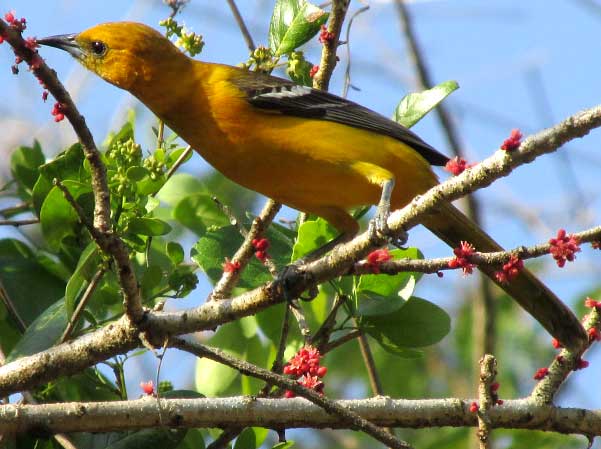
from the April 3, 2016 Newsletter issued from Hacienda Chichen Resort beside Chichén Itzá Ruins, central Yucatán, MÉXICO
ORIOLES SIPPING FLOWER NECTAR
The Spanish Plum tree, Spondias purpurea, in front of the hut is flowering, its tiny, red blossoms held in pea-sized clusters along its outer branches. Here during the heart of the dry season, especially in early mornings and late afternoons, I've noted a new feature of this fine tree, which is that a nice variety of birds visit it to walk along its branches dipping their beaks into one flower after another, clearly sipping nectar. The most commonly seen bird is the Altamira Oriole, an immature individual of which is shown taking a long, deep sip at www.backyardnature.net/n/16/160403oo.jpg
from the June 12, 2016 Newsletter issued from Hacienda Chichen Resort beside Chichén Itzá Ruins; limestone bedrock; elevation ~39m (~128ft), N20.675°, W88.569°; central Yucatán state, MÉXICO
BLACK IGUANA EATING SPANISH PLUMS
Most mid-afternoons as I'm working at the computer, at one point or another a motion catches my attention through the openings of the pole wall beside me, I glance outside, and see something like what's shown below:
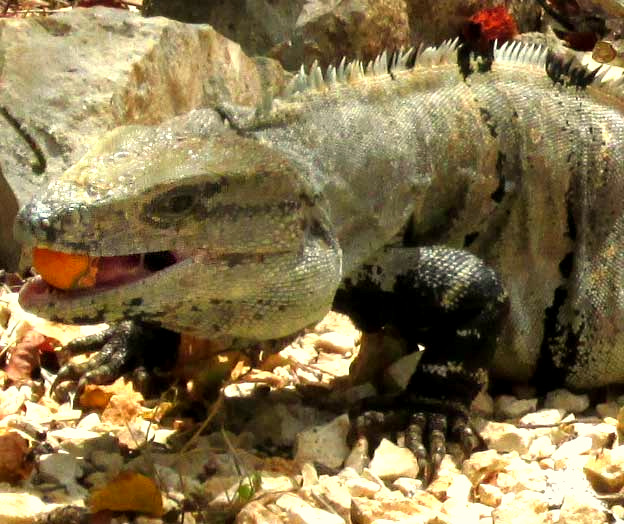
That's a Black Iguana feeding on a ripe Spanish Plum fallen from the tree behind the hut. One thing worth noting is that those Spanish Plum fruits consist mostly of a large seed surrounded by just a little flesh. Somewhere our hut iguana must be leaving piles of poop substantially composed of Spanish Plum stone-type seeds.
One reason the above picture is worth posting is because it documents a known species feeding on another known species, and such specific documentation often is hard to come by. Their Wikipedia page says that Black Iguanas are "... primarily herbivorous, eating flowers, leaves, stems, and fruit, but they will opportunistically eat smaller animals, eggs, and arthropods."
Now we are closer to answering which fruits Black Iguanas eat, as well as which dispersal agents help the Spanish Plum disseminate their seeds.